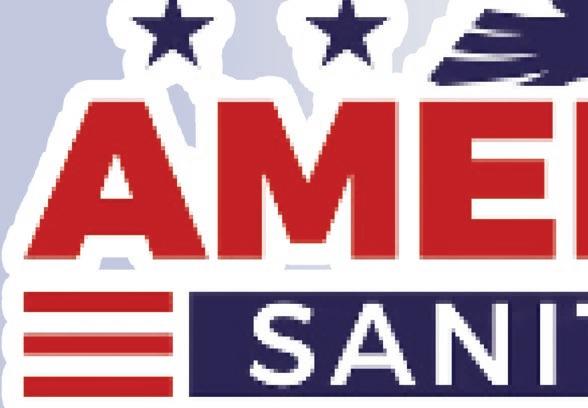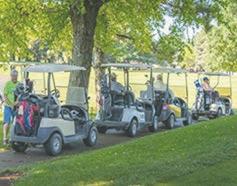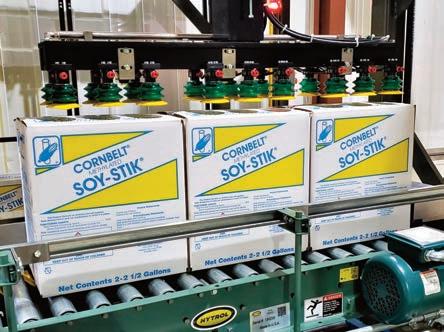EducationProgress 2025

“Regardless of grade point average there is a basic Cessna scholarship available to each student which was $250 last year.”


“Regardless of grade point average there is a basic Cessna scholarship available to each student which was $250 last year.”
By KOLLEEN TAYLOR
Fifty years ago, Webster City High School students were learning about a former student who left a bequest unlike anything most schools had ever seen. It is a gift that is still providing a boost to students in Webster City today.
Thousands of Webster City graduates have benefited from William Cessna through the scholarship fund designated in his will.
Cessna was a journalist who grew up in Webster City, but never finished high school here.
Kathy Biere, business manager and board secretary/treasurer for the Webster City Community Schools, manages the Cessna scholarship fund which is invested in 19 different certificates of deposit. She also manages another 50 scholarships.
“Our mission has always been how can we give the best educational experience to kids? We are trying to develop good citizens for the community. That’s the whole idea.”

“Regardless of grade point average (GPA) there is a basic Cessna scholarship available to each student which was $250 last year,” Biere said. “Those with a GPA of 3.4 or higher get an additional $100, and those with a GPA of 3.75 get an additional $200 or $550.”
In addition, there are 12 Cessna departmental scholarships, recognizing excellence in those areas. These are given for science, math, agricultural science, art, business education, English, world language, family consumer science, industrial technology, music, PE/ athletics and social studies.
“The (basic) Cessna scholarship is given for eight semesters, but it
See SCHOLARSHIPS, Page 7B

Kathy Biere, business manager and secretary/ treasurer of the Webster City Community School District Board of Education, reviews the many certificates of deposit supporting the scholarships that are available to Webster City High School graduates. Fifty years ago, Webster City High School students were learning about a former student who left a bequest unlike anything most schools had ever seen. It is a gift that is still providing a boost to students in Webster City today.
By KOLLEEN TAYLOR
No one really knew William A. Cessna. This is what we do know. He was one of nine children who grew up in Webster City. A brother, Albert Cessna, returned to Webster City to explain the will and tell more about William, according to an article written in a 1973 edition of the School's Journal published by The Daily -Freeman Journal.
He attended school when the Depression hit the hardest. He never graduated high school in Webster City and it was speculated that, like many families, he was needed to help bring in money or food for the rest of the family. His father was Charles I. Cessna. They lived in an apartment on Seneca Street. They didn’t have much. No one did during those years. He married a young woman who also grew up in Webster City and graduated high school here. Her name was Wave Richard, the daughter of H.D. Richard, of Webster City. They had no
Career Ag Academy aims to build productive
By LORI BERGLUND
In Iowa, there’s a good chance that whatever job a person has, that job has a strong connection to agriculture. Lawyers make some of their best money writing farm partnerships, LLCs, trusts, and estate planning for Iowa farmers. Bankers lend to farmers, and need to know the ins and outs of agriculture. Retailers sell everything from boots and combines to farmers. Restaurants serve prime rib and the folks behind the meat counter help us select the best pork loin from the case. High school teachers, university professors, and researchers, also make a good living from agriculture.

The Coalition to Support Iowa Farmers estimates that nearly one in five Iowans has a job today because of agriculture. More than 385,000 Iowans work in agriculture, with approximately 44 percent of those working in some form of animal agriculture.
Those numbers, and the need to fill those jobs for the future are the driving reasons behind the new Career Ag Academy set to open in the 2025-2026 school year in Webster City.
“It’s extremely important,” to prepare and draw more students into ag-related fields, said Gene Gourley, board president with the Career Ag Academy. Gourley envisions a learning environment where students who have little connection to the farm can learn more about the role of agriculture in Iowa and the nation’s economy. Students will gain hands-on experience with animal agriculture and related fields throughout agriculture. The project is a joint venture with both the Hamilton County Fair Board and Webster City
— Daily Freeman-Journal
Floral Hall at the Hamilton County Fairgrounds will be coming down early this year to make room for the new Career Ag Academy at the fairgrounds. The building will be a classroom and lab for students, and will also be available for fair and public use.
By LORI BERGLUND
It was the entire purpose of the Morrill Act, signed by President Abraham Lincoln in 1862 — practical education focused on agriculture, mechanical arts and home economics. It is Science with Practice, as Iowa State University, which came into being as a result of the Morrill Act, has long proclaimed.
But practical education needs to start long before the university level. With vocational education, high schools begin the process of preparing students for work. Webster City High School is in the midst of a rededication to the principle of providing practical education that helps prepare students for a lifetime of work — from welders to farmers, bankers to lawyers.
“We need students that will come to the labor force with skills and knowledge, and a good work ethic,” said Kurt Veldhuizen, voc-ag instructor, who also works heavily with Career Technical Experience — CTE — at Webster City High School.
Veldhuizen’s department has grown rapidly this year with the addition of three new agriculture teachers since the beginning of the school year.
Taylor Adams, a 2023 graduate of Iowa State, joined the department at the beginning of the year. She is teaching subjects ranging from Introduction to Agriculture, Agronomy, Plant Science, and Greenhouse Management.
“We also have a Crop Production class that is dual credit with Iowa Central,” she noted.
Adams is a co-advisor for the Webster City FFA Chapter, along with Veldhuizen. She has been working this winter with the freshman students preparing for FFA contests
Built on the present site of Floral Hall at the Hamilton County Fairgrounds, the 50-foot by 90-foot metal building will feature two classrooms with walls that can be removed to create one large multi-purpose room. That room may also be available for community use. There will also be modern restroom and shower facilities in both the classroom and livestock areas. The fact that the fairgrounds is already zoned for agriculture made the site ideal for a new livestock classroom.
“Ag teachers have told us that one of the biggest challenges they face is that urban kids are not exposed to farm animals,” Gourley said. “They don’t know how to work them, or how to handle them. I can show them pictures



in Conduct of Meetings and Creed Speaking. In these areas, students learn parliamentary procedure, public speaking, as well as working together as a team.
“The students have grown so much and we are all learning together,” Adams said.
Still in the midst of her first year of teaching, Adams has been impressed with the level of school and community support in Webster City.
“It’s cool to see a program grow so much in less than a year,” she said. “We have great support from the community and administrators. I really enjoy the students and staff here.”
Two additional teachers joined the department in January. Due to contract
of animals, but with today’s biosecurity, you just can’t take kids out to the farm anymore.”
The task of creating a curriculum for the Career Ag Academy falls largely to Kurt Veldhuizen, long-time voc-ag teacher and FFA advisor at Webster City High School. The school has also bumped up its voc-ag staff considerably to help with the course load.
(See related story.)
“The current plan is that at the start of the school year, the fall of 2025, we will be having classes out there,” Veldhuizen.
Construction is set to begin this spring and the building is slated to be open and ready for use by the fair board in July. While that’s an ambitious construction schedule, Veldhuizen

by Lori Berglund
— Daily Freeman-Journal
The team of agriculture teachers has more than doubled in the last year at Webster City High School, growing from one teacher to four teachers. From left are Zach Brecht, who joined the department in January 2025; Taylor Adams, who started in August 2024; longtime teacher Kurt Velduizen; and Alyson McCarty, who joined the department in January 2025.
restrictions, they are teachers-only and are not FFA advisors at this time.
Zach Brecht is the Ag Shop specialist. His classes range from ag power and technology, ag equipment maintenance, small gas engines, ag metals, welding, metal fabrication, ag electrical, and ag plumbing.
Alyson McCarty also joined the staff in January and is focused on ag business, sales, natural resources, and woods specialist. Her coursework ranges from natural resources, ag woodworking, ag business, ag systems technology, risk management, landscaping and turfgrass management.
“We really envision being back to full CTE and having all these options that match up to a student’s career interest,” Veldhuizen said. “I would like to start a Lynx Career Internship program, not to replace courses that students take, but to match them up with local business mentors to help get them started with real-world career experience.”
Veldhuizen also pointed to two other
said confidence is high that it will be ready to go.
“Of course, like any building project you never know 100%, but we’re very optimistic,” Veldhuizen said.
Once open, the curriculum will span several academic levels, with even some dual college credit available in at least one course. While freshman classes will still be held at the high school, beginning at the sophomore level all classes will be at the new Career Ag Academy.
“We will have the ninth-graders out there about once a month doing labs and field work,” Veldhuizen said.
very important CTE departments, including business, and family and consumer science — FCS — studies.
“Sandy Alne is a second-year teacher and she teaches in our business department,” Veldhuizen said.
Business classes range from accounting to entrepreneurship and much more. Family and consumer science is another important area, but even after offering special incentives, Webster City High School was unable to fill the position for the current school year.
“Sadly, this school year we were unable to find an FCS teacher, but we are actively looking,” Veldhuizen said. “Hopefully, in the 2025-26 school year we will be back to full strength.”
Family and consumer science covers everything from cooking, an always important skill that is increasingly overlooked, as well as such things as interior design, child care, and much more.
Honest Abe, who found time to sign the Morrill Act even in the midst of the Civil War, would likely have approved of this continuing adoption of the principals of the Morrill Act — Science with Practice — and building good citizens prepared for a world of ever-changing career options.
people in Iowa and throughout the world.
“Food insecurity is already a growing issue,” Veldhuizen said. It’s easy to make the correlation that without knowledgeable people in agriculture, the ability to feed the world becomes threatened.
At the senior level, students will explore Advanced Animal Production I and II, and the hands-on work picks up in intensity for the students who have progressed in their knowledge through the underclassmen courses.








Even younger middle school and elementary students will occasionally be invited out for field trips. It’s easy to envision younger students enjoying a late spring day at the fairgrounds, seeing the animals at the Career Ag Academy, and using the horticulture and landscape of the fairgrounds as an all-day learning experience.
Beginning at the sophomore level, all animal science classes will be held at the Career Ag Academy.


“In Vet Science I, we focus on learning about the body systems of animals, reproductive systems, digestive systems,” Veldhuizen explained. “In Vet Science II we learn about caring for animals, nutrition, disease and how to treat animals.”
Survey the Animal Industry is a junior level course offered as dual credit with Iowa Central Community College.
“This course even transfers to Iowa State for an animal science credit,” Veldhuizen said.
“These kids will be in charge of the animals in the facility,” Veldhuizen said. “I envision working with Gene Gourley in having kids learn about the science of doing feed trials — how does feed intake relate to growth rate.” Responsibility, both in the workplace and in the care of another living creature, is another important aspect of these upper level classes.
“The students will be in charge every day of making sure animals are fed, watered and housed appropriately.”
While these may be animal science classes, students will have to use skills throughout the broader curriculum. They will be writing reports using language and communication skills. They will have plenty of experience with math and science as they conduct feed trials and learn about anatomy and biology.







The spring semester companion to this class is a course that focuses on meat science.
“We will have classroom capabilities to study more of the meat sciences,” Veldhuizen said. “We have several local employers in this area, and we want to help kids understand where the careers are at, and the work needed to provide protein products for an evergrowing world.”
It’s not just about putting a great cut of meat on the grill; it’s really about feeding
“Honestly, I think this is going to hit any career, just from the standpoint they will have so much responsibility,” Veldhuizen said. “This is about learning responsibility, respect, problem-solving, and those are skills that anyone has to have out there in whatever career they follow. … You’re a much more valuable lawyer or banker if you understand the industry that your clients are in.”
To Gourley, it’s about building good citizens, regardless of the career path they eventually follow.
“Our mission has always been how can we give the best educational experience to kids?” he said. “We are trying to develop good citizens for the community. That’s the whole idea.”























“We’ve always been

“We can talk about
It's OK to talk about your faith here.”
By LORI BERGLUND
Harry S. Truman was in the White House in the fall of 1952 when St. Thomas Aquinas Catholic School opened its doors for the first time. The building wasn’t quite done, but with the help of a large church basement, the 99 young students made do until the building was ready for occupancy at just about the time Dwight Eisenhower won his first term in November of that year.
The Baby Boom was in full swing and wouldn’t peak until 1957, with 4.3 million little Boomers coming into the world the same year Sputnik orbited the earth and worried Americans far and wide.
In Webster City, it was a time of growth for all local schools.

Rather than a competitive atmosphere, Webster City Community Schools and St. Thomas have always enjoyed a warm, working relationship.
The public school system at that time was packed with young learners, filling six elementary buildings, known as Hilltop, Riverview, Lawn Hill, Elm Park, Pleasant View and Sunset Heights. Its use would change, but even South Building was still in use for many of the Baby Boom years.

St. Thomas became the community’s seventh grade school, serving students all the way through the eighth grade in its early years.
Today, consolidation of services has reduced the number of buildings for public schools. And St. Thomas — even with the youngest Baby Boomers now over 60 — this little school continues to grow and play a vital role in local education.
This year, some 115 students are enrolled in preschool through grade six.
Theresa Schleisman is in her sixth year serving as principal. A veteran of nearly 20 years at Ames middle and high schools, Schleisman found retirement wasn’t nearly as rewarding as working with kids.
“I’ve always been in a school setting,” Schleisman said.
It was her husband, who had become acquainted with St. Thomas through his work with CenturyLink, that first started singing the praises of St. Thomas to his wife.
“You should check out that school,” he told me, Schleisman recalled. “It’s a gem of a school.”
photo by Lori Berglund
— Daily Freeman-Journal
Above: Mrs. Adalie Hayes shares a book with her first-grade students at St. Thomas Aquinas school in Webster City.
below: Sixth-graders Carsten Hrnicek, left , and Elsie Heffernan find a comfy place for some independent reading and study time at St. Thomas Aquinas School.
bottom: Fifth-graders Leena Humlicek, left, and Liana Veldhuizen take a moment from their studies at St. Thomas Aquinas School to offer up warm smiles on a cool winter day.


She talked with a few fellow educators who were also familiar and heard similar recommendations. She applied, and soon took the reins as the new principal.
But while it’s a much smaller school than anything in Ames, she finds the challenges just as demanding.
“It can be a real challenge,” she said. “I feel like I work harder here than I ever did in Ames.”
If one thing is true about a small school, it’s that everyone pulls together — staff and parents included, Schleisman noted.



She praised the St. Thomas community for its support of the school.
Heidi Tesdahl is development director for St. Thomas. She is proud of the school for its commitment to both strong academics and faithful service.
“We’ve always been able to show our academic excellence,” Tesdahl said.
Small class size is a big benefit, especially in today’s busy world.
“Typically, our class sizes range from eight to 18,” Schleisman said. “It creates a better atmosphere, and more



of a family atmosphere. Our teachers really get to know our students well.”
With smaller numbers, teachers have greater flexibility to spend additional time with students as needed.
“Teachers can do more oneon-one time with students,” Tesdahl said. “It helps them get to where they need to be. We expect our students to be at a certain level, and if they are struggling the teachers are working very hard to get them there.”
At the same time, both Tesdahl and Schleisman offered their respect and appreciation to teachers throughout the local public system.
“Our public schools do a great job,” Tesdahl said. “The numbers just allow us something different.”
Another difference at St. Thomas is the ability to make God a part of every aspect of the school day.
“We can talk about God,” Schleisman said with a warm smile. ‘It’s OK to talk about your faith here.”
Throughout its long history, St. Thomas has always been open to children and families of any faith. Even families who have faith traditions other than Christian have chosen the school for its academic and value system.
“We’re open to students and families of all faiths,” Tesdahl said.
It’s a place where children can learn, and they can do so guided by common values such as goodness, kindness, and honesty.
The school may have changed over the years, but its mission of helping educate good citizens, guided by the light of faith, has never changed.

















“The manufacturing and technology program is a hands-on learning experience where students have access to state-of-theart milling and lathing machines.”

“Students have access to cutting edge technology with the use of an Anatomage table.”


By CHRIS FULLERTON
EAGLE GROVE — Iowa
Central’s North Central Regional Center — NCRC — has been serving students in the broader community since 2014. Located at 216 South Park Drive in Eagle Grove, the site housed the Iowa National Guard for more than 50 years. In 2014, the building was donated to Eagle Grove by the National Guard and, with the foresight of community service, then-Eagle Grove Mayor Darrell Betterman and Iowa Central board member Dr. Dan Kinney proposed to use the site for its current purpose: an educational bridge to a college degree.
The NCRC enrolled its first students in 2014 while still under renovation.
Today, enrollment in the NCRC and all of its programs, which are designed to help students determine their career pathways, are 100% free to high school students from Eagle Grove, Webster City and Clarion. All credits earned at the NCRC feed into other Iowa Central programs and transfer to state universities.
NCRC offers several career pathway programs.
The manufacturing and technology program is a handson learning experience where students have access to state-of-theart milling and lathing machines, as well as their own welding station. The focus of the program is on welding, metal working and blueprint reading. This two-semester program earns students 17 credits.
The Health Sciences pathway program is designed for students who are interested in the health field. Students can study to become a Certified Nursing Assistant (CNA), take nursing prerequisite courses such as Human Anatomy and Physiology I and II, Nutrition and Developmental Psychology. Students have access to cutting edge technology with the use of an Anatomage table. This table is the size of a hospital bed, covered by
See EG, Page 5B

top: Students work with stateof-the-art mills and lathes in the Manufacturing program.
left: Students have access to an Anatomage table.
bottom: More state-of-the-art equipment. opposite pAge: Life-size mannequins provide a realistic learning experience in the Health Sciences pathway program.





Once enrolled, the career navigators help students remove barriers to continuing their education by finding solutions for daycare, transportation and program material costs.

Iowa Central Community College, Webster City campus, offers free HiSED — High School Equivalency Degree — Program
By CHRIS FULLERTON
Over the past 10 years, students from ages 17 to 70 have taken advantage of the free HiSED program offered right here on the ICC Webster City campus.
Two instructors lead the classroom instruction. Paula Persell-Brain, who has been with the program for eight years and also serves as a career navigator, and John Hughel, whose teaching career in the GED and HiSED programs has spanned more than 40 years.

Studying for the HiSED is no small task. Students must pass five subject area exams: reading, writing, math, science and social studies.
The HiSED program uses a selfpaced, computerized curriculum that is tailored to each student's needs. Students take assessment tests and the curriculum adjusts to the student’s knowledge base, so students only study what they do not know.
The instructors work one on one with students in all subject areas to ensure student comprehension and confidence in the subject matter.

Upon completion of the program,
Continued from Page 4B
a giant touch screen and connected to a computer.
The instructor can project realistic images of the human body, all of its systems, and can manipulate the image to show any number of abnormalities for student observation and study.
Students also practice real life skills in the classroom with the use of mannequins, that are full body patient simulators.
Classrooms emulate a true hospital setting with beds, wheelchairs and common equipment found in nursing facilities. At the conclusion of this program students earn 18 credits.
The Teacher Academy pathway prepares students interested in entering an academic teaching career. This program offers coursework related to the principles of teaching.
Courses may include Educational Psychology, Biology, U.S. History and Music Appreciation. This pathway allows students to earn 19 credits.
students who enroll at Iowa Central part time receive a $250 scholarship. Those attending full time receive a $500 scholarship.
The program currently graduates an average of 20 students per year.
Instructors assess the needs of the students and assist interested students with enrollment into non-credit integrated career pathway programs after the completion of the HiSED program. These non-credit classes
include CNA — Certified Nursing Assistant, welding and CDL — Commercial Drivers License — programs. Once enrolled, the career navigators help students remove barriers to continuing their education by finding solutions for daycare, transportation and program material costs. Maria Gomez is a recent graduate of both the HiSED program and the integrated CNA program. She started the HiSED program with trepidation after being out of traditional school for a number of years. Yet with perseverance and guidance from her instructors, she not only completed her HiSED, but also her CNA and has gone on to become a phlebotomist.
Looking ahead, Melissa Vorrie, director of Adult Education and Literacy said, “The goal is to increase integrated classes to serve the region and to increase HiSED enrollment.”
To learn more about all of the education opportunities in this program, text Paula Persell-Brain at 507-200-1319. The next orientation sessions are March 4 and March 6.

The High School Options program allows students from Eagle Grove High School to earn their high school diploma at the NCRC. This is a self-paced program where students receive in-class lessons in math, reading, writing, as well as science and social studies fundamentals. Students work with computerized curriculum at their own pace and level to prepare for the High School Equivalency Test (HISET). Upon completion of this

program students may enroll in Iowa Central classes and degree programs.
Undecided students may consider the Liberal Arts pathway, which offers a variety of courses from the fields of science, social science, and humanities that can filter into associate degree programs at Iowa Central.
Additionally, NCRC offers English Language Learner (ELL) classes for adults 18 and over; day and evening classes
are available. Students use computer-based curriculum and textbooks to acquire the English skills they need to succeed in the workplace and their community.
What makes NCRC unique?
Colleen Bartlett, Career Academy specialist, spoke about the positive transitional and socialization aspects that the Center provides students.
“Students come from small towns and have grown up with their classmates,” she said. “In this environment, they meet new students and learn to navigate new partnerships in and out of class. It is their first experience with a college level class that has different expectations from high school. The rules are different, the instructors are unfamiliar and the learning platforms are different. Students learn to be more independent as they make their way through the program.” She recalls a student who came back to visit after some years who told her that he never thought he could go to college, but attending the program gave him the confidence he needed and he is now enrolled in a Master’s program.
The North Central Regional Center can give the community's high school students a free head start in obtaining a college degree or a trade.
For more information on the enrollment process, contact Colleen Bartlett at 515574-1974.







"It is not a school for students with behavior issues.” Rather, it is a place for students at risk of not graduating on time due to any number of circumstances to obtain rapid credit recovery through self-paced and traditional classroom learning.

By CHRIS FULLERTON
Whatever stereotypes you may have about alternative schools, leave them at the door when you step inside the classrooms of Hamilton High at the Webster City Iowa Central campus.
Walking through the doors, the space resembles a cozy cafe with a variety of comfortable seating options, walls lined with books, a kitchenette and coffee at the ready. This warm welcoming environment is a refuge for students who are willing and ready to complete their work on their own terms in a quiet, supportive environment.




Jeremy Brown, head teacher at Hamilton High, explained what makes this school unique.
"It is not a school for students with behavior issues.”

Rather, it is a place for students at risk of not graduating on time due to any number of circumstances to obtain rapid credit recovery through self-paced and traditional classroom learning.
An average day may include a blend of independent work, where students use online curriculum, e-2020, which guides them through lessons with text, video and assessments as well as in person instruction from Brown.
A traditional classroom setting is used for in-person lessons. Classes last about an hour per subject.
Currently, students are learning about astronomy, business math, pop fiction, government, applied science and geometry.
Brown is a teacher with 27 years of experience and has worked at Hamilton High for the past seven. In that time he has seen an increased demand for the program.
The school is able to accommodate up to 25 students per year. Students graduate throughout the year, so enrollment numbers constantly vary.
Regardless of when students finish the program, they all walk together at commencement in May and receive their high school diploma from Webster City High School.
“Students who come into the program at risk of not graduating then graduate early, go from a place of hopelessness to hope,” Brown said.
The main priority of Hamilton High is to have students graduate on time. Students are selected for the program based in part on their ability and willingness to work independently. Overall success in the program is student-driven. Students work in a smaller, quieter, self-paced environment where their motivation is key to completing the program. They are often eligible for dual enrollment at Iowa Central and are able to earn college credits while still attending Hamilton High. Parents or students that are interested in this option should speak with their high school counselor to see if the program would meet their needs.







Center: Students work independently on e-2020. They are, from left, Peyton Moberly, Clancy Parr and Matthew McBroom. bottom: At Hamilton High, there is comfy seating and books for browsing.


























Continued from Page 1B
Webster City has an unusually high number of locally financed scholarships. Biere manages more than $4 million in scholarship funds, which includes the Cessna scholarship money. Each year the Webster City High School has a Senior Night when as much as $250,000 has been awarded.
doesn’t have to be consecutive,” Biere said, “but they do have to fill out the form each year, and they have to tell us if they transfer schools.”
Any student attending an accredited university, community college or vocational school full time can reapply each year. Students don’t have to begin college immediately after graduation and they can take a break from school and apply again when they start back. Some don’t realize they still can access this scholarship beyond the year they graduate.
“Every graduating senior qualifies for a (Cessna) scholarship,” Biere said. “But the students who apply for the Cessna scholarships have to be full-time students at the institution they attend. Those requirements are different at each school.

“The Cessna scholarship may

only cover the cost of one book,” she continued, “but it’s still a book they need for their classes.”
HigH number of local scHolarsHips
Webster City has an unusually high number of locally financed scholarships. Biere manages more than $4 million in scholarship funds, which includes the Cessna scholarship money. Each year the Webster City High School has a Senior Night when as much as $250,000 has been awarded.
The amount varies each year, as the scholarships change each year.
Many scholarships are available through Webster City High School counselors Marta Paukert and Shelley Powers. But not all scholarships are managed through the Webster City Community School administration. If they are managed by the schools, they confirm that the student who
received the scholarship is still enrolled, before sending any money to the institution.
“The high school counselors determine which scholarships will be offered each year and then the Business Office pays them out according to the information we receive from the counseling office,” Biere said. “Kathy Malaise-Runyan verifies the information with the schools. The counselors send us the list of kids and where they are attending, then she confirms this, and pays each school.” Malaise-Runyan handles the accounting for the school district, working closely with Biere.
There are other scholarships in addition to the Cessna scholarships that can be accessed for four years, but most are only offered as students graduate their senior
left: Some 1975 Webster City High School graduates were the first recipients of the William Cessna scholarships. below: The first year of the Cessna scholarship awards is highlighted. bottom: A School's Journal reminder to apply for the Cessna.
year of high school. A partial list of available scholarships are located on the Webster City Community School website. The link to that scholarship page is https://highschool.wcschools. org/academic-and-guidance/ scholarships. The deadline for completing the applications through the school is March 18. Senior Recognition Night is scheduled for May 14. This is when most of the scholarship recipients are announced. For more information on scholarships offered directly through colleges or other institutions, you can contact their administrative offices. Other groups, such as churches, community organizations and service clubs also may have scholarships set aside for members and students would have to make direct contact to those organizations.

children. What prompted William Cessna to leave his estate to the school district from which he never received a diploma? Was it the fond memories of the wrestling team where he was considered a fine lightweight wrestler or the Boy Scout troop where he disrupted a meeting? Was it from the neighborhood playmates, or the friendships and memories he cherished over the years? This we will never know. William A. Cessna did attend the University of California and worked as a reporter, first at the The Register and Tribune in Des Moines and later for the Chicago Tribune.
He and his wife were avid travelers and during one of their trips into the Blue Ridge Mountains they purchased a small resort, which they expanded. That property was left for the scholarship fund and sold to fund the Cessna scholarships for the Webster City Community Schools.
As stated in his will, school administrators were required to invest the money from his estate and build up enough interest to pay out scholarships each year.
In 1975, the first scholarships were paid out of the income received from the operation of the resort. That



year, $22,000 was available to local students planning to further their education.
Today that fund, now under the management of the Webster City Community School District’s business office, totals nearly $2.5 million. The amount available for scholarships has ranged from $20,000 to $31,000 each year, depending on interest rates.
Cessna died in the early 1970s at the age of 70. He left instructions that the schools could set the criteria for the scholarships, but it had to go to Webster City graduates. The administration at the time decided to distribute the money
not for a single scholarship, but created a legacy fund that would provide for any student who wanted to attend any university, community college or a trade school — and not only just for one year — but for up to four years.
Cessna was reported to be friends with MacKinlay Kantor, but as far as community members from Webster City, he was not well-known or remembered as someone to be highly successful. Yet he managed to help fund the education of thousands of Webster City students, and will continue to do so for many years to come.











At Van Diest Supply Company, people make the difference. We have a sincere interest in our customers’ business and a genuine desire to help. We strive for long-lasting relationships with our customers, suppliers and Team Members.
At Van Diest Supply Company, people make the difference. We have a sincere interest in our customers’ business and a genuine desire to help. We strive for long-lasting relationships with our customers, suppliers and Team Members.
Our tradition revolves around providing products and services that consistently exceed expectations. Serving Agriculture since 1956, a three generation family owned business, we are know for our longevity, stability and continued growth.
Our tradition revolves around providing products and services that consistently exceed expectations. Serving Agriculture since 1956, a three generation family owned business, we are known for our longevity, stability and continued growth.
Van Diest Supply Company employs over 600 people, has 55 buildings on approximately 270 acres in Webster City, Iowa, has 20 outlying Distribution Centers and serves over 6,000 customers across the Midwest. Join us a part of our Winning Team by filling out an application today!
Van Diest Supply Company employs over 600 people, has over 55 buildings on approximately 270 acres in Webster City, Iowa, has 20 outlying Distribution Centers and serves over 6,000 customers across the Midwest. Join us as a part of our Winning Team by filling out an application today!









